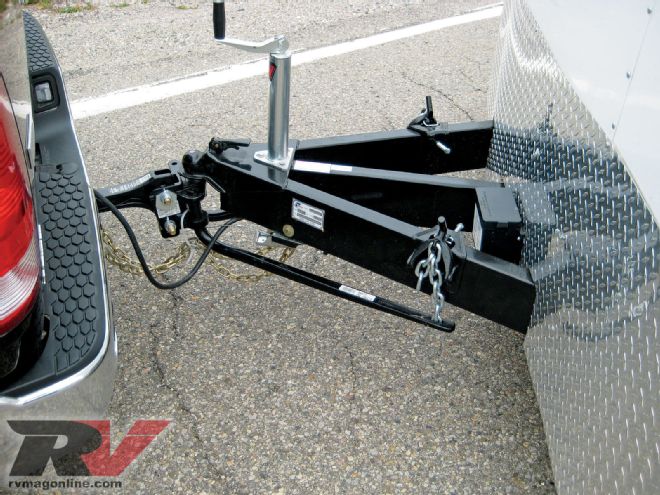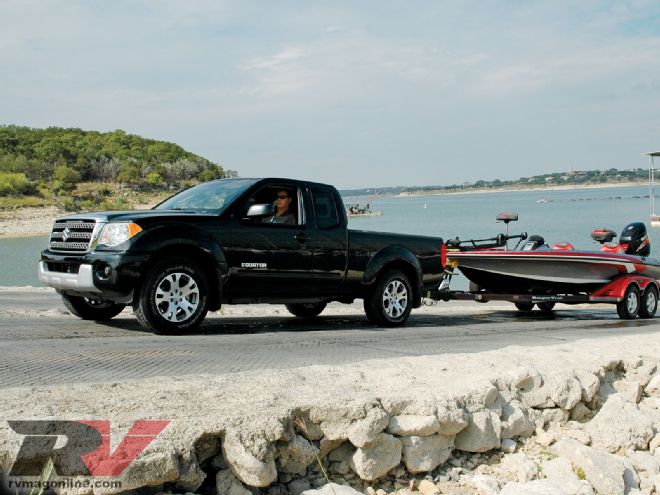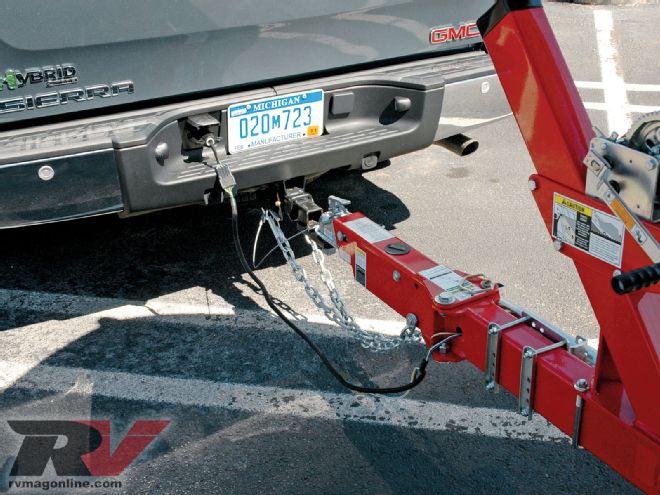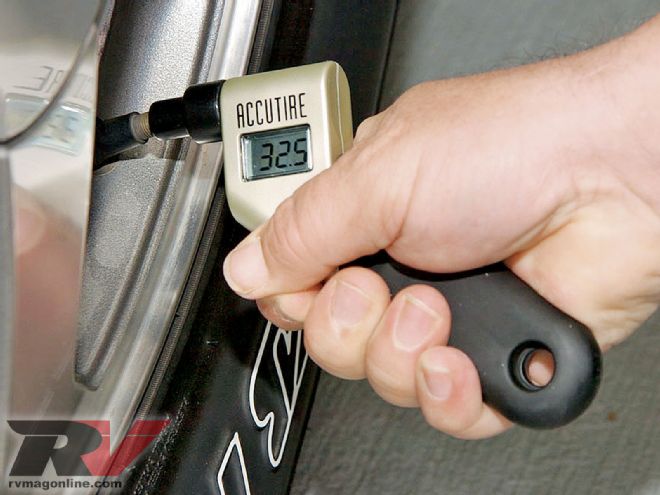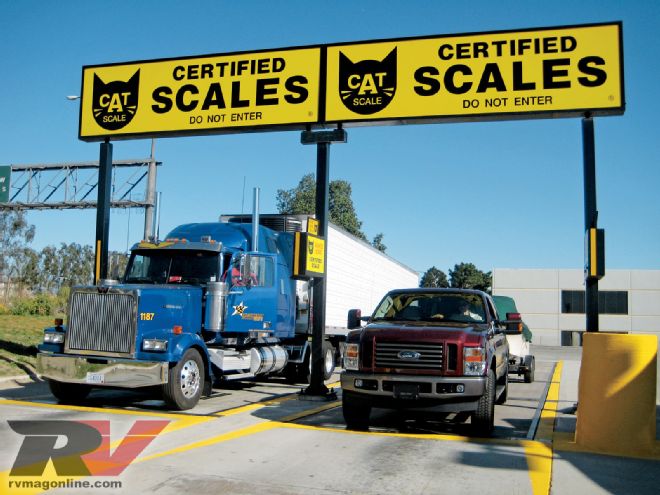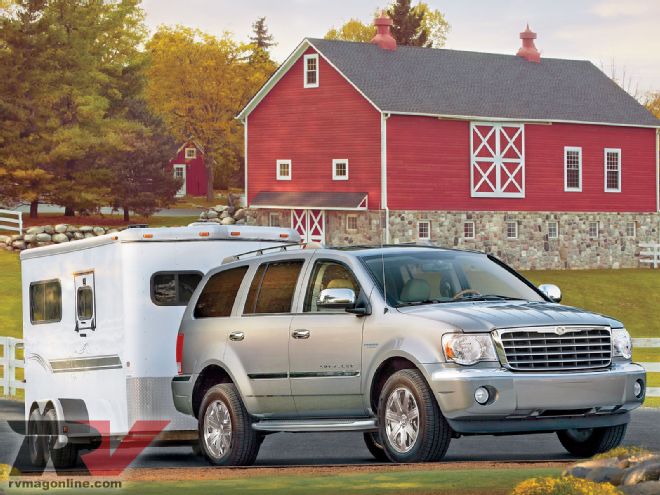For most people the question is simple: Can my vehicle tow the trailer I want? The answer, unfortunately, is not so simple. There are standards and regulations to consider, equipment to ponder, and arithmetic to do.

| This midsize SUV can tow up to 7,500 pounds when equipped with Kia's 4.6L V-8 engine, or 5,000 pounds with the 3.8L V-6. Because it has disc brakes, a ladder frame, and automatic transmission, the Kia shown here can tow more than the average crossover or compact SUV. Here it is shown towing a 241/2-foot Keystone Ultra Light Passport. Because the Passport weighs 3,880 pounds empty and 5,930 fully loaded, it should be within the towing capacity of the Borrego so long as a weight-distributing hitch is used.
Towing is a delicate balancing act that puts everything at risk, even more so when the tow vehicle is marginal. No matter how many miles you may have covered, each foray onto the highway is another roll of the dice, and there is nothing routine about it. Nobody tows for fun. We do it because we have to.
Any time you connect two wheeled vehicles, you make one new vehicle with completely different handling characteristics, and a different set of laws apply. Should there be an accident, not only could you lose the truck and trailer, but people could get hurt, and you could be found liable if your rig is overloaded or improperly hitched. That could get really ugly. Your insurance company might not cover the damages if you are operating illegally, and you could be held personally responsible for financial restitution for other parties involved. Managing the risk is a matter of doing your homework, getting the right equipment for the job, and driving in an appropriate manner.
Recognizing that not everyone has a 1-ton dualie at his disposal, manufacturers offer relatively lightweight travel trailers, some quite generously sized. That makes it possible to enjoy RV travel safely using lighter tow vehicles-minivans, crossover SUVs, or compact pickups-with the right tactics and equipment. These lightweight trailers come with good brakes and wide stances and are easier to tow. But that does not mean that they can be towed without concern for the specifics. It's easy to mismatch the trailer and tow vehicle, and unfortunately the consequences of doing so can be severe. Figuring that out for sure requires some homework.
Step 1: The Owner's Manual
For starters, you need to know the actual capacities of the vehicle you tow with. Even identical-appearing trucks may have different towing capacities, so you need to check the owner's manual and carefully apply the specs to your particular vehicle.

| Your owner's manual will chart all the different towing and hauling capacities based on equipment, body type, engine, transmission, axle ratio, and hitch type. There might be separate charts for Gross Combined Weight Rating, another page for Gross Trailer Weight (GTW) with tongue weight for every given hitch type, and yet another chart for maximum load weights (GVWR). Be sure you are looking at the right numbers. Usually the same information is available on the websites of the manufacturers, such as www.ford.com.
This is easier said than done, because the charts can be complex. Towing capacity ratings for a typical pickup might run 8-10 pages of fine print, charting multiple configurations. The ratings vary by engine, 2WD or 4WD, automatic or manual transmission, and by axle gearing, cooling capacity, type of hitch, type of trailer brakes, tire capacities, and even the weight of the options on the truck. Some of these are obvious features; some-such as axle gears-are not.
For example, take the Suzuki Equator pickup, also sold as the Nissan Frontier. The truck is advertised to tow 6,500 pounds "properly equipped." By checking the owner's manual, you will see it can handle 6,500 pounds, but only if it's the V-6-powered, Extended Cab, 2WD version with the automatic transmission and Sport Package. All others are rated to tow less, and in some combinations much less. A four-cylinder 2WD Equator, with the manual transmission, is rated to tow 3,500 pounds, no more. This is not at all unusual. Typically the actual towing capacity of a given vehicle will be substantially less than advertised.
If you no longer have the owner's manual for the vehicle you want to tow with, usually towing capacity information is on the manufacturer's website (or you can probably find a replacement on eBay). To check axle ratios in vehicles like pickups, which are offered with multiple ratios, you may have to climb under your truck and find the axle tag or housing stamp.
Step 2: The Door Sticker
A second source of information is the Vehicle Identification sticker on the inside of the driver's doorjamb. It will say what the Gross Vehicle Weight Rating (GVWR) is and how much weight each axle can carry. It also specifies the exact tires you must use, the exact wheels, and the exact tire pressure. This, combined with the information in your owner's manual, will tell you how heavy a trailer you can tow, how much cargo you can put in the tow vehicle, and how much tongue weight your combination can handle, given the hitch you plan to use.

| Half-ton pickups often come with V-8 engines and optional towing packages that allow them to tow up to 9,000 pounds. But be aware: Identical-looking pickups may have very different towing capacities. Best to check the Vehicle ID sticker.
The door sticker information underlines the need to pay strict attention to wheel and tire engineering. It has become stylish to equip new trucks with larger aftermarket wheels and lower-profile tires. Dealers do it to dress up a truck for quicker sale and so they can charge more. Unfortunately, if your truck or SUV does not have the OEM tires or wheels, it may very well have compromised towing capacity. After checking the door sticker, compare the numbers to the data on the tire sidewall to make sure you have the correct tire and wheel combination. Most important would be to take note of the given load limit. Generally, light truck tires have load ratings between B and E, with B being the lightest and E the heaviest.
You should also be aware that lug nuts are key wheel components that absolutely must be torqued to the proper spec. Those custom lug nuts that come with stylish alloy wheels may not be Department of Transportation (DOT) approved fasteners or may not have the same length of thread engagement your OEM wheels had. Locking lug nuts installed for security reasons may also create a weak link. If there is any doubt in your mind about the capacities of the wheels and tires you have and the fasteners you are using, it would be wise to reinstall the standard combination or lighten your load accordingly.
Step 3: Get the Right Gear
"Properly equipped" usually means having the right hitch, a matched hitch ball, a properly adjusted trailer brake controller, and towing mirrors. Most manufacturers' ratings are based on the assumption that you will be using a weight-distributing hitch; ratings for a simple weight-carrying hitch will be much lower. A weight-distributing hitch takes weight off the rear axle, enhancing carrying capacity and stability. Your best bet is a well-designed, weld-in type of hitch, which is generally better quality than bolt-on hitches. The hitch ball itself needs to be matched to the weight of the trailer. Just like everything else, they come in a variety of rated strengths and capacities.
You'll need reliable brakes in your tow vehicle-the stronger the better-and reliable brakes in your trailer. To coordinate the two sets of brakes, you'll need a good brake controller adjusted such that the rear wheels brake strongly enough to be felt and in concert with the tow vehicle's brakes, but without locking the trailer's wheels. The controller can be installed at any trailer/towing service center, or you can install it yourself if you don't mind doing simple wiring. If you have a new truck, trailer, or controller, it would be wise to take the combination for a testdrive or two before you head out on the vacation trail, just to get the tuning right.
Visibility is another priority. When towing, your rearview mirror will be blocked and your side mirrors useless. Extended towing mirrors are needed. They're available in a wide variety of styles and price points, from clip-on ones to more permanent, bolt-on mirrors. It would be really scary to hit the road without them.
Step 4: Managing Tongue Weight
Tongue weight is actually the hardest requirement to address and one of the most important to get right. Too much tongue weight overloads the rear axle, which could blow a rear tire or melt down the axle gears. With the front end pointing to the sky, steering and braking will be sketchy.

| This 2-inch hitch ball is Class III, meaning it can carry a load up to 6,000 pounds. Hitch balls are defined by their shank diameter, shank length, and ball diameter and can look similar but vary widely in strength. It is essential to ensure that the hitch ball is rated for the same weight as your hitch, or higher. Ratings are usually stamped onto the ball.
On the other hand, with too little tongue weight, the trailer will haul up on the rear axle of your truck, so you'll overload the front axle and front brakes and have almost no rear brake effect at all. And the hitch could come off the ball with a single bounce.
As a rule, manufacturers specify that the tongue weight be 10-15 percent of the total load. If your trailer weighs 5,000 pounds, tongue weight should be 500-750 pounds. This could be too much to check using a bathroom scale but too light to check at the truck scales. There is a way to use a bathroom scale to check tongue weight. It involves taking a 3-foot board with a brick at one end and the scale at the other. If you place the coupler 1 foot away from the brick and 2 feet away from the scale, the scale will show 33 percent of the tongue weight. Multiply the number by three to get the tongue weight.
While it is possible to approximate tongue weight that way, the most practical solution is to go by how level the tow vehicle sits. You can do this visually, or you can actually measure from the top of the wheelwells to the ground, loaded and unloaded. If you find the tow truck sitting at an unlevel attitude, move cargo around until the combination is leveled out. The goal is to distribute the load so that all the tires share an equal part.
Step 5: Visit the Scales
Once you have your rig loaded to your satisfaction, it's time to visit the scales. Most people have no idea what the actual weight of their trailer is or how much their gear weighs. Remember, the weight of everything in your tow vehicle-passengers, food, tools, gear-takes away from the amount of trailer weight you can safely manage. You'd be surprised how much weight a pickup truck or SUV can gain when a family hits the road.
You could weigh all your gear piece-by-piece on a bathroom scale as you load up, but the easy way to know what your truck and trailer actually weighs is to visit the certified truck scales. You can find the nearest one in the phonebook or on the web. When you get there, talk to the scale's operator so he understands you want to weigh the trailer alone (Gross Trailer Weight), the truck alone (Gross Vehicle Weight), and finally the combination (Gross Combined Weight). That's three weights, which will require that you unhook the trailer, so you may want to bring some help when you go. This sounds like a lot of trouble, but it will only take half an hour and cost about $20.
Once you have weighed your trailer, you will get receipts to prove that you are in compliance with recommended weight limits. Those could be handy in case your transmission or axle burns up, for warranty reasons, or in a court of law in case of an accident.
Step 6: Know Your State Laws
It doesn't seem fair, but numerous conflicting state laws govern trailer length, weight, brake standards, width, height, and towing speeds, among other things. You might talk with your trailer vendor to make sure you are in compliance when you buy your trailer. Problem is, even if your trailer complies with the laws of your home state, it might be a ticket waiting to happen the next state over. The solution is to check the regulations both in your state and the states you might tow through. An Internet search for "towing regulations" will call up all the information you need. You'll find a hodge-podge of laws with little rhyme or reason.

| 7 Vital Steps For Better And Safer Towing gmc Truck And Trailer
As a rule, the maximum trailer height is 13 feet 6 inches, but 17 states do permit 14-foot height. One state, Nebraska, allows trailers to be 14 feet 6 inches tall.
In most places the maximum trailer width is 8 feet 6 inches, but in three states it is 8 feet, and in one state, Hawaii, it is OK to be 9 feet wide.
Maximum trailer length ranges anywhere from 40 feet (13 states) to 53 feet (5 states). In 12 states there is no maximum length at all. Maximum combined rig length varies from 85 feet in Wyoming to 55 feet in Maryland, and ranges widely in between.
Maximum towing speeds can be as high as 75 mph (8 states) or as low as 45 mph, as in Alaska. In California you are required to tow at 55 mph with trailer brakes on your 1,500-pound, 14-foot-tall, 81/2-foot-wide trailer, with 65 feet as your maximum overall length. When you get to Arizona, the same rig is illegally wide by 6 inches and illegally tall by 6 inches, but you can go 70 mph.
In Massachusetts it is fine to tow a 40-foot trailer weighing 10,000 pounds at 65 mph without trailer brakes; but in Maine, if your trailer weighs just 3,000 pounds, you better have trailer brakes. In Tennessee, trailer brakes are required if your trailer weighs 1,500 pounds; in Utah it's 2,000; in Oklahoma, 3,000; in Delaware, 4,000; in Alaska, 5,000; and in Massachusetts, only when your rig reaches 10,000 pounds.
It may take a trip back to the trailer dealer to get set up to comply in neighboring states, but it could save you a couple of tickets and keep your insurance company on your side if the worst should happen.
Step 7: The 10-Minute Checklist
Before you pull out, just take one more look around for peace of mind. Check to see that brake lights and turn signals are still working. Make sure the tow vehicle looks level, lug nuts are tight, and trailer safety chains are crossed, with enough slack so you can turn. Make sure the locking pin is in place on the tow ball lever and that the breakaway cable is plugged in.
Adjust the mirrors so you can see the length of the trailer. Wheel chocks stowed? Tongue load looks good? Tongue jack is raised and locked so it can't drop down while you drive? With those things confirmed, you can drive with confidence.
Safety Tips
It pays to be fanatical about tires. You can't be cautious enough about checking tire pressure, especially when towing on the highway where heat builds up quickly. All it takes is one blowout on truck or trailer to ruin your weekend. The pros use pyrometers to check tires at rest stops, to find out if any are building up heat. If one tire is hotter than the others, there is always a reason why, with tire pressure being the most obvious culprit.
Another common source of trouble comes from trailer bearings. This is more common on boat trailers, which get dipped in water regularly, but even on travel trailers the hubs get hot in a very short distance. Condensation can seep into hot hubs as they cool, which causes rusting and lubricant failure. Maintain that grease well and there will be no problems. Bearing grease is usually colored-coded by temperature rating. The higher-temperature greases cost more, so you can balance the type of grease you need against the amount you tow.
Towing requires a major change in driving style, for a variety of reasons. On flat ground and dry pavement, stopping distances will be about 50 percent longer, so allow plenty of room to stop. The rule is to allow at least 4 seconds of distance between your rig and the vehicle in front of you.
Become sensitive to wind and weather. Wet pavement makes it even harder to stop, so when weather kicks up, your following distance should increase to 6 seconds. At 65 mph, that's as much a 576 feet, almost three football fields. It sounds like a lot of room, but on a compromised surface you'll need all of that to bring your rig to a safe stop.
Severe crosswinds are another hazard, so take wind warnings seriously. It's better to slow down or pull over rather than tip over in the next gust.
Be aware of hills. Going uphill, heat is the enemy, and on the down slope, stopping distances increase.
In low-speed maneuvering and parking lots, think about where your back wheels are going. Trailers with tandem axles or triple axles require much longer turning distances than trailers with a single axle.
Given all of the above, it's clear that towing requires undivided driver attention. That means no cell phone, quit fiddling with the radio, and concentrate on the road ahead and your immediate surroundings. To be really safe when towing any trailer, you have to be thinking a good quarter of a mile ahead.
Improve Towing Capability With a custom hitch and proper attention paid to tires and wind resistance, even unlikely vehicles like this Buick Enclave can become satisfactory tow vehicles for surprisingly large trailers. If you find that your truck is overmatched, it may not be practical to upgrade, but there are a few things you can do. By installing lower (numerically higher) gears, you may be able to get a heavier-than-advisable load rolling without stressing the transmission, rear axle, and cooling system quite so much. But you will have to tow at lower cruising speeds because of it, and mileage may suffer.

| 7 Vital Steps For Better And Safer Towing truck And Rv
Another tactic would be to add cooling power, which might include a bigger/better radiator, an oil cooler and/or a transmission cooler, and temp gauges. The transmission, another limiting factor, can often be beefed up with a billet torque converter and re-programmed using a chip that allows you to lock up the torque converter on hills. With the transmission not hunting between gears so much, it will live longer. Newer pickups often have a "tow/haul" button on the shifter for just this reason.
A custom hitch can also make a difference. Factory hitches are "on the light side," says Andy Thomson at Can Am RV, a Canadian RV specialty outfit. "A lot of hitches are made to ship cheaply and bolt on easily," he says, so they make towing capacity a secondary priority. Thomson is a lifelong RVer who regularly writes on the subject of hitches for various RV publications. "We think about 5 percent of the trailers on the road today are really hitched up well," he estimates. According to him, when a tow vehicle, car, or truck does not tow well, it's not always the fault of the vehicle.
"People assume it's the vehicle, but more often, it's the hitch. A lot of crossover SUVs are really very good tow vehicles. They have independent suspensions, which gives them a wider stance for stability and, with a unibody, a lower center of gravity. We've done well with Ford Edges and Buick Enclaves, and we've done over 1,000 minivans since we've been in business."
At Can Am, custom hitches are designed to spread loads over a much longer distance, moving the load toward the center of the vehicle. Careful attention is paid to the distance the hitch ball is from the vehicle, so that unwanted leverage is kept to a minimum.
"It's not so much the weight of the trailer," Thomson tells us. "The weight really only matters on hills and acceleration."
Limiting factors? "Ninety percent of the time it's aerodynamic drag," Thomson says, adding that even slightly taller trailers can be much harder to tow at highway speeds. "The trend toward bias-ply tires also adds rolling resistance. We won't let a trailer go out with bias-plys."
Because new trailers generally have good brakes, the braking power of a tow vehicle has become less of a concern. He says, "It's pretty hard to buy a trailer without adequate brakes these days."
